Exploring marriage migration
Migration is a worldwide phenomenon attributed to changes brought about by globalisation—the configuration of work and the homogenisation of culture. Most people travel to work, many settling for low paid and risky jobs, pushed by stagnant economic development and dire lack of opportunities at home. In the Philippines alone, an estimated 8 million Filipinos are abroad. Roughly fifty percent of them are overseas workers while the other half are migrants. But it’s not Filipinos alone who are going abroad. Many foreign or overseas workers are now joined or have themselves become migrants, people who move to seek permanent settlement in countries other than their own for an infinite number of reasons as well as in an infinite number of ways. The World Bank estimates about 15% of the world’s population now reside not in their countries of origin but elsewhere.
This phenomenon complicates the issue of migration in ways uninterrogated in the past. For one, marriage in migration is an aspect that has been little explored. The formation of families and consequently communities of “foreigners” in countries most often wealthier than the countries of their origins have produced identities, situations, and dilemmas that are destabilising, at the very least disturbing, for individual migrants, families, communities and governments linked by such journeys. The political and cultural responses to this phenomenon now appear to be exciting fields of concern to social movements, and in particular to feminists’ movements worldwide. For increasingly these people are made up of women who are workers, more informal than formal, both at home, and in fields and factories.
This issue of Women In Action (WIA) devotes itself to initiating, if not joining in, a discourse on marriage and migration with a range of themes for interrogation. A quick overview of marriage migrants’ situations points to the significance of democracy, specifically radical democracy, as the context for examining issues of citizenship, with a strong emphasis on feminist perspectives of citizenship, such as intimate citizenship. When families form, communities soon follow. This community building inevitably involves multiple cultures that has now been referred to as diasporas. This is not in any way a one process formation but more like an innumerable one, making women, their children, and families vulnerable to a host of human insecurities yet little known in current literature. Thus, human security in diasporas is an integral part of this issue’s exposition.
The field of marriage and migration is wide. Perhaps, other WIA issues will continue to explore it. Civil society is currently engaged in policy advocacy and service provision to mitigate the dire situation of marriage migrants. Moreover, cultural politics perspectives appeal to the need for culturally nuanced responses, whether as researchers, advocates and service providers. Much work remains to be done and the year 2008 presents another welcome opportunity to stoke the fires, lighten paths to change, service and better lives.
Maureen Pagaduan
Guest Editor
ARENA fellow
Where are the women in marriage migration?
Marriage is a persistent, ever-evolving subject for feminists. One of its variations, marriage migration, has been affected by neo-liberal policies via feminisation of poverty and has increased in magnitude in the last two decades in Asia. The situation of marriage migrants challenges us with its wide range of problems, issues, and discourses, given that migration is intertwined with practices of gender, race and class. Marriage migration also covers diverse discourses of citizenship. It requires the engagement of feminist critics vis-à-vis existing notions of liberal citizenship in which the nature of access to economic, social, civil and political rights are deeply gendered.
Marriage migration in Asia has received much attention recently, especially from destination countries. But the question of representation must be raised. Who is talking about whom and whose voices and stories are being heard? These crucial questions receive little attention. When we discuss marriage migration, priority should be given to listening to women’s voices and contextualising women’s specific experiences.
In this spirit, I express deep appreciation to Women In Action. It has worked hard to capture the dialogues of women in the last few decades. It has opened up spaces for us to explore many issues and challenges on marriage migration. They do this through diverse ways, from tapping writers and concerned researchers, to dialoguing with marriage migrants who have their own stories to tell. No simple measure or solution exists to the many problems we face, but this effort on the part of Women In Action helps us make an important step
towards progress.
Jiyoung LeeAn
Guest Editor
ARENA Programme Officer
Aiming to further examine the current situation of marriage migration in Asia at the local, national, and regional levels, the Asian Regional Exchange for New Alternatives (ARENA), in collaboration with Korea Migrant Women Human Rights Centre, Isis International-Manila, and Kanlungan Centre Foundation, Inc., organised the 2007 Regional School on Marriage Migration in Asia: A Platform for Research and Action. Held on November 10-13, 2007 in the Philippines, around 35 NGO activists, researchers, and marriage migrants service providers from six different Asian countries discussed issues related to marriage migration such as human (in)security, citizenship, and diaspora. This issue of WIA (Women in Action) features some of the papers presented during the said regional conference.
Janice Lopez
Managing Editor
Insecurity Among Mongolian Marriage Migrants
The transition to a market economy in Mongolia started in 1990 with a series of economic shocks that placed enormous pressure on all aspects of life. This was an unfamiliar phenomenon for Mongolians who had lived for generations with expectations of entitlements from the state to protect them. Women increasingly had to fill the gap left by the withdrawal of social services which in turn limited their capacity to take up income generating opportunities. Apace with the sudden loss of economic and social security came an increase in domestic violence, alcohol abuse, personal insecurity and family breakups in the wake of migration, both internal and external. 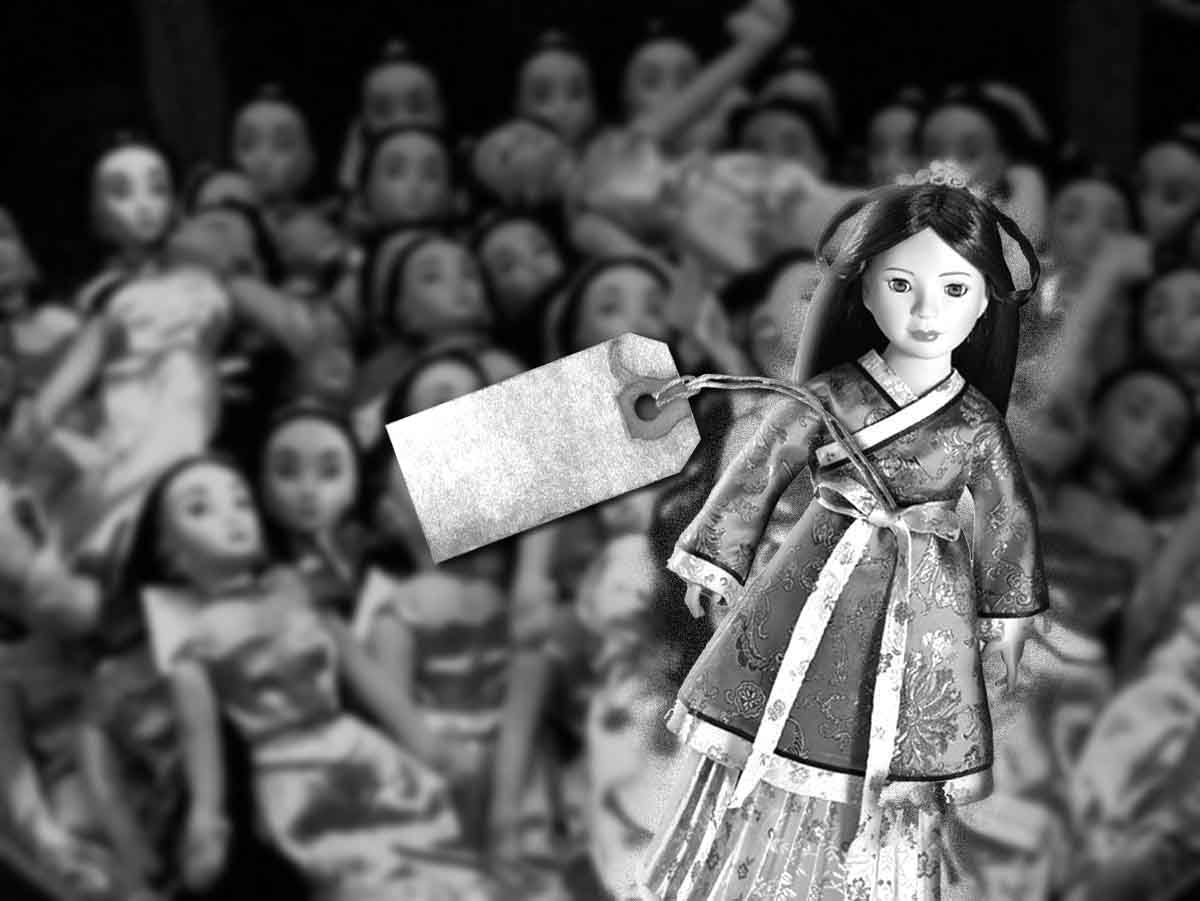
In 1992, a new Constitution was adopted establishing rights that have since been incorporated into domestic laws. This constitution established the right to travel. Coupled with social and economic dislocation, this has resulted in a dramatic increase in Mongolian people’s mobility. Over the past decade, the number of Mongolians studying and working abroad has grown to an estimated 100,000 people. Similarly, there has been an increase in domestic migration from rural to urban areas. The general belief is that going abroad improves living standards as well as one’s quality of life. Unsurprisingly, marrying foreigners is increasingly becoming a common strategy used by Mongolian women to move and go abroad.
Trends in Marriage Migration
The most common way to marry a foreigner is through both broker agencies and individuals. The broker and brokered person connect through various ways including newspaper advertisements, TV chat, and internet information hotlines, as well as through friends and relatives.
The broker agency:
The broker agencies are the more popular means of marrying foreigners, and most broker agencies represent Korean broker agencies. The broker agency needs per mission from the Mongolian Ministry of Justice and Labour, but so far, only one broker agency has registered as a non-government organisation (NGO). Nevertheless, the broker agencies, though mostly Korean, also have ties in Japan, USA, Switzerland, and France.
The individuals:
There are individuals who arrange marriages with foreigners and work in much the same way as do the agencies. The main difference is that individuals do not have an office nor address. Among friends and relatives, for example, a woman who married a Korean was able subsequently to arrange marriage between her husband’s friends and her own friends and relatives. This form of marriage arrangement is harder to control because it is embedded in relationships.
Sample Case: A thirty-year old woman from the countryside had made several attempts to marry a foreigner before succeeding. She would tell her friends she was going abroad, leave for the city to “display” herself to potential husbands, and after several trips she was selected to be a wife. She now lives in Korea with her husband and is helping to arrange for friends and relatives to have a similar fate. Her sister also helps find women from the rural areas to become potential wives.
In the factory and work places:
Once a woman has found employment in the country of her choice, it is common for her to try and marry her boss. The purpose of this marriage is to be able to remain in the country and change one’s status to legal from an illegal work status.
The newspaper advertisement: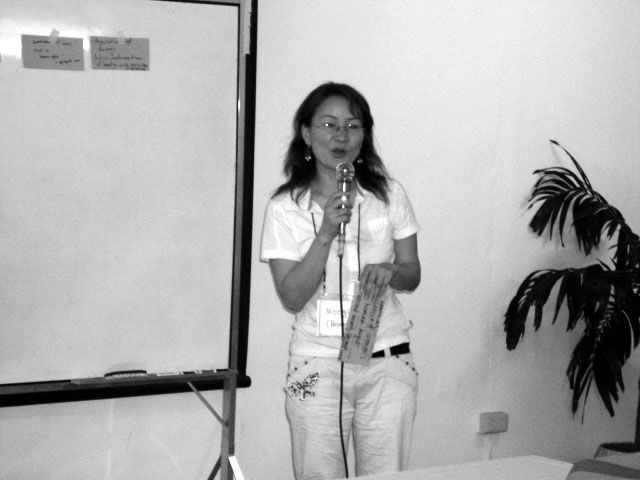
A typical advertisement in the newspaper will specify age, usually between 20-35, and describe the person and her status, e.g., single without a child, pleasant personality, thin and pretty, etc. The contact number is commonly a mobile one without any postal or street address.![]()
The TV chat:
Recently, local TV channels began producing TV chats. Mostly young people use the TV chat, sending SMS (Short Message Service) messages to one another while watching video clips. The broker agency and individuals have found this an efficient and effective way to run their businesses. Subsequently, the use of TV advertisements have increased and are still increasing.
Marriage migrant women face severe challenges as their marriages are founded on wrong and deceitful information and subsequently flounder.
The information hotline:
Information hotlines are becoming more commonplace. Mongolia has 4-digit numbers that are more expensive but easier to remember (e.g., 1904). Four-digit hotlines have increased, which shows a concerted effort to broaden the reach of arranged international marriages. The broker agencies are certainly utilising the marketing power of these hotlines.
Face to Face with Human Insecurity
There is no guarantee to safety in marriage migration because most broker agencies and individuals do not have agreements with the other country’s broker agencies. Many move abroad expecting their new husbands to protect them. Broker agencies and individuals market their services only by showing photos of couples and how they live happily after using marriage brokers. To prove it, brokers show copies of the migrant women’s visas.
There are no agreements in place with the husbands or the broker agencies and the women are not informed enough to require such agreements. At the same time, women do not have a sufficient knowledge about their future husbands nor aware of any criminal record their husbands may have. There is no data on how many women returned and how many women have divorced. Neither is there information regarding the number of women that have complained to the broker agencies and how such issues were resolved. There is no documented feedback from the women at all.
Issues and Necessary Actions
Marriage migration raises a number of complex issues. There is the issue of divorce, of children orphaned or traumatised by the separation. There is the issue of crime, with migrants at high risk of being trafficked, enduring conditions of slavery and even disappearances. Marriage migrant women face severe challenges as their marriages are founded on wrong and deceitful information and subsequently flounder. Then there are differences in culture, age, language, and education. During their stay in the country of destination, often they suffer from lack of information, abuse and domestic violence. There is the constant battle against discrimination, loneliness and hostility.
A case in point involves a Mongolian married to a Swiss who attempted to leave the country with her child. She was arrested at the airport after her husband filed a police report charging her with kidnapping the child.
It is difficult to find specific data and information on cases although we can cite a few statistics. The marriage migration data from Centre Citizens’ Registration for the last 5 years, for example, show that the number of people who married “foreigners” is more than 2500, most of them women. The marriage migration data at the Wedding Ceremony Palace in 2004 show that 500 couples celebrated their wedding there, and that 80 out of the 500 couples married “foreigners.” More specific reports on marriage migrants in Mongolia are still forthcoming.
What makes things worse for women is the attitude of law enforcement authorities and society in general that migrant women enter into private agreements with the men they marry and therefore cannot be considered victims.
When women finally summon the courage to divorce or escape from abusive relationships, most of them do not want to return to their home countries for lack of money; they are also overwhelmed with feelings of failure and shame. So far, no support system has been created to help and rehabilitate these women, both on the state and NGO levels.
Clearly, the marriage migrant situation calls for an amendment of the Mongolian Family Law, Advertisement Law and National Plan of Action on Commercial Sexual Exploitation and Trafficking and other laws to regulate marriage through broker agencies. There is a need to control broker agencies and advertising, both by the State and NGOs. 
Finally, Mongolians need to learn from experiences in other countries and work together as a network with receiving countries. And it needs special rehabilitation services to victims of marriage migration and protection of rights of cross-cultural kids.
Conclusion
If the current marriage migration continues to increase, it will impact on the state of insecurity of marriage migrants in Mongolia. If people see the marriage migration data and compare the number with one of other countries, it might seem that the number is small. But considering the small population of Mongolia, this is not small number at all.
A Vietnamese Woman Tells Her Story
I am originally from Vietnam but lived in Korea for 13 years. I came to Korea as an industrial trainee and was less paid than the Korean workers. There were 30 Vietnamese factory workers, making fishing nets. Many of the Vietnamese workers could not return home after their 3-year contract because they had debts to pay, money they borrowed to pay for the chance to work in Korea.
In my case, I could not return because I fell in love with a Korean colleague and he proposed marriage. We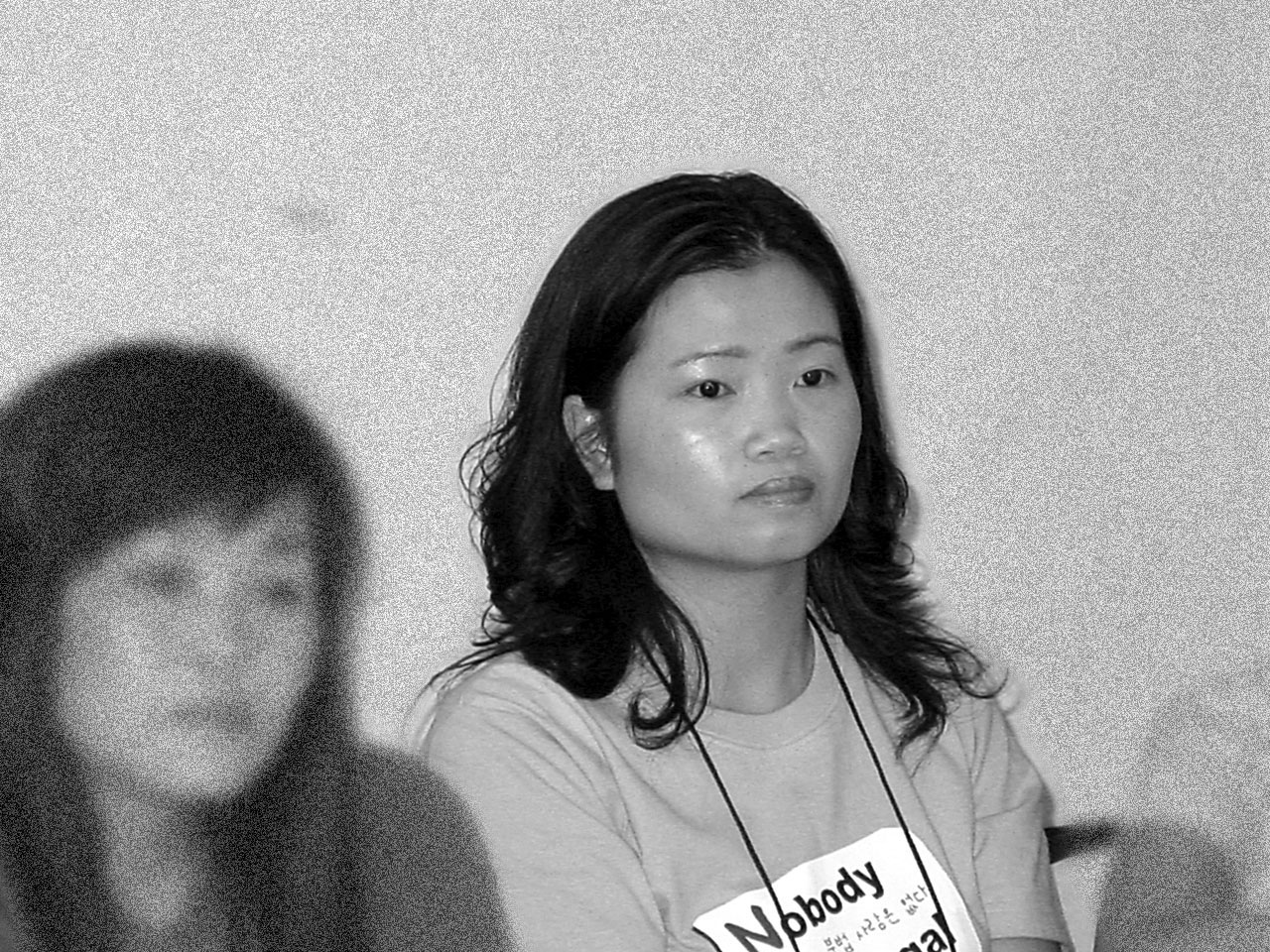 now have two sons and I am satisfied with my married life. A few years ago, my Vietnamese friends and I joined Foreign Workers’ Human Rights in Busan (FWR) to study Korean. We could converse and communicate in Korean, but we wanted to learn more and become more fluent because we were concerned about our children’s education. Since last year, I taught Korean to Vietnamese brides who recently entered Korea and I have also worked as their guidance counselor. I teach Korean culture to Vietnamese wives and Vietnamese culture to Korean husbands for better communication among couples. These are my tasks in Eulim. Now, I would like to share my experience as an immigrant bride and the path I took to self-empowerment.
now have two sons and I am satisfied with my married life. A few years ago, my Vietnamese friends and I joined Foreign Workers’ Human Rights in Busan (FWR) to study Korean. We could converse and communicate in Korean, but we wanted to learn more and become more fluent because we were concerned about our children’s education. Since last year, I taught Korean to Vietnamese brides who recently entered Korea and I have also worked as their guidance counselor. I teach Korean culture to Vietnamese wives and Vietnamese culture to Korean husbands for better communication among couples. These are my tasks in Eulim. Now, I would like to share my experience as an immigrant bride and the path I took to self-empowerment.
Problems of Migrant Women in Korea
Recently, there has been an influx into Korea of immigrant brides from Asian countries. One in ten marriages is Korean-Foreign, and 70 percent of these marriages are between Korean men and Asian women. However, most marriages are conducted by commercial brokers. Many immigrant brides are considered “sold’ just like commodities and many Korean husbands think they can buy their wives with money given to brokers. Understandably, many difficulties arise for couples who have different languages and cultural backgrounds.
Most brides expect a better life in Korea but they realise they have been conned as soon as they arrive...Many migrant brides suffer from domestic violence or economic problems, severe intervention by in-laws or their husbands’ incapabilities.
Daily, I get phone calls and visitors, asking for advice about their married life, conflicts with their husbands or mothers-in-law and so on. Some ask me to translate for them so they can communicate with their Korean partners. Some girls run away from violent husbands and ask me to find shelter for them. Some girls simply cry, longing to return to Vietnam but they don’t have the money to do it.
Better Life in Korea but…
The brokers sometimes give false information to both prospective brides and husbands. They make a lot of money and try their best to match as many couples as possible, given that they receive around USD 10,000 to 15,000 per brokered marriage.
Most brides expect a better life in Korea but they realise they have been conned as soon as they arrive. The reality is far from the rosy picture which had been painted for them. Many migrant brides suffer from domestic violence or economic problems, severe intervention by in-laws or their husbands’ incapabilities.
Many Korean husbands and in-laws also receive false information about foreign women, and are lured by stereotypes, e.g., that Vietnamese girls are so beautiful and obey their husbands more than Korean women are inclined to do, or that Filipinas are excellent mothers and care for their babies well.
In a way, these heartbroken women are living in war conditions, and everyday is a day of struggle to survive.
Many brides are made to believe that their Korean husbands are so rich they can afford to send around 300 USD per month to their families back home. In reality, the husbands are usually of low-income groups and are older, and some brides can hardly expect a monthly allowance from their husbands. Thus, many women want to work to earn and send money to their home countries. But the husband or in-laws are usually suspicious of their intentions. They worry that the immigrant brides will run away. As a result, some brides get confined to their houses and others are totally isolated. Their Korean dream soon shatters. In a way, these heartbroken women are living in war conditions, and everyday is a day of struggle to survive.
Eulim for Migrant Women and Multi Cultured Families
Eulim (Migrant Women & Multi Cultured Families Centre), which opened in March 2005, is a sub-organisation of the Association for Foreign Workers’ Human Rights in Busan. “Eulim” means harmony in Korean language. The Eulim counseling programmes for migrant women include Korean language classes, cultural, and various programmes for empowerment. Programmes such as family camps and multicultural education seek to help them better understand each other. For the children, there are cultural education classes to understand their parents’ culture, art and other academics. For the Korean citizens, there are Asian Culture Festivals, and for worker couples, there are child delivery and counseling aid programmes.
We, at Eulim, wish the migrant women and their families a better life in Korea. We would like to pioneer in helping Korean society become more open to other cultures instead of discriminating against migrants. Everyone should be able to enjoy human rights anywhere in the world.
Working in Eulim
1) Teaching Korean language to Vietnamese brides
I was in the first Korean class for migrant women at Eulim in 2003, and 6 Vietnamese women attended Korean class in FWR. The following year, we had many friends coming from China, Indonesia, and the Philippines. Now, we have almost 70 students from around 10 different nationalities. Migrant women usually come to Eulim with their children. More than 10 Korean volunteers teach Korean language, baby sit and cook lunch for migrants. I am one of two foreign teachers, and I teach the beginner’s course to Vietnamese brides. Aside from teaching the language, we also share our experiences and know-how, discussing life issues such as how to better understand their Korean husbands, child rearing, etc. After class, we have lunch together—all the Korean volunteers and different nationalities—and then wash dishes by turn. It is a good time to share our feelings and cooperate with one another. I am proud of myself when I get to help and serve as a role model for migrant brides in many ways.
2) Counseling, Translating, and Interpreting
There are more than 12 staff members in FWR including Eulim’s three migrant women counselors, a Chinese, a Filipina and myself. Korean staff members cannot understand all of the migrant workers’ languages so the migrant staff ’s work is key in communicating with our clients. I am counseling not only immigrant brides but also foreign migrant workers who are in manufacturing, shipping, etc. I listen to them very carefully and discover that often their problems involve unpaid salaries, changing company jobs, or industrial accidents. I usually transfer the problems related with workers to the labour counseling department at the office. Alone, I can handle immigrant bride issues such as husband-wife quarrels or conflicts with in-laws. But when legal assistance is needed, I have to transfer the case to the Korean staff who can handle it as well.
3) Special education programme for migrant women
There are many programmes for immigrant brides such as education for pregnant women, economic skills training, etc. When I first joined FWR, I was a trainee but now I can give skills training to Vietnamese women and share experiences on life in Korea.
4) Culture Day
Eulim designates a Culture Day for every nationality. We prepare the programme ourselves with help from Korean volunteers. We usually cook Vietnamese food and even sing songs wearing the Aodai (Vietnamese traditional clothing). Many Korean volunteers and other migrant women compliment us when we do this. Other groups perform as well. We enjoy thoroughly when we do this and learn how to live together with people who have different cultural backgrounds. I organise the Vietnamese women and take part in the programme as an emcee. We are proud of ourselves because we succeed in sharing our cultural values and appreciate other
people’s ways.
5) Special training programmes for immigrant staffs
Seminars
Migrant women staff and Korean staff are given a lot of chance to attend seminars or education programmes. Last year, I went to Seoul for an international seminar, and it was the first time I took the KTX (speedy train), the first time for me to go somewhere without my family.
Visiting Japanese NGOs
This year, I got a chance to visit Japanese NGOs. It was quite impressive to meet Filipina immigrant women who organised by themselves and run their organisation with the help of Japanese volunteers. Recently, I went to Vietnam with the Korean International Organisation for Migration (IOM). The purpose of the visit was to give proper information to potential marriage immigrant women who want to marry Koreans. The visit aimed to protect them from brokers’ false information. I took part in the education session for Vietnamese counselors in Ho Chi Minh as well.
There, I met a returnee who had stayed in our shelter in 2005. She told me that for a long time, she could not work in Vietnam. She had 6 family members to support but there was no work. She wanted to come back to Korea but unfortunately, there was no way she could do that. When she was in Korea, she could not stand her husband’s maltreatment. But when she returned to Vietnam, the family was still poor, and she saw no improvement in their lives at all. She was poor before marrying a Korean but she was as poor after returning from Korea, and talking to her made me sad.
I met three bride returnees, as well as many young girls who want to marry Koreans. In Korea, I meet a lot of victims who suffer because of their husbands. But despite this knowledge, there are many girls who still want to marry Koreans. They know many Vietnamese girls suffer from maltreatment. A Vietnamese bride, Huan Mai, was even beaten to death in July this year. But still they want to marry Koreans. Why? They want to escape poverty and expect a much better life in Korea, but the dream does not happen. As a Vietnamese, I am so sad about this situation.
Conclusion
I am a wife and mother of two sons. If I were a fulltime housewife, I would worry if my children would be isolated from their peers simply for having a Vietnamese mother. But through my work, I now have self-confidence and try to motivate other immigrant women to be empowered. I believe that my children would be good adults who have Korean-Vietnamese cultural values passed on by a loving mother.
Leny Tolentino on Women Empowerment of Marriage Migrants in Japan
Leny Tolentino is a Catholic Filipino lay missionary doing pastoral work for Filipino migrants in the Diocese of Yokohama for the past 18 years. The closure of her former diocesan migrant office in 2002 gave birth to the KALAKASAN Migrant Women Empowerment Centre, an organisation committed to address violence against women. “Kalakasan,” a Tagalog word for strength, stands for the inner strength of the woman that, once recognised and reclaimed, can lead to transformative personal empowerment and collective action.
Based on her experiences in KALAKASAN Centre, Leny shared with Isis International-Manila her thoughts on women’s empowerment.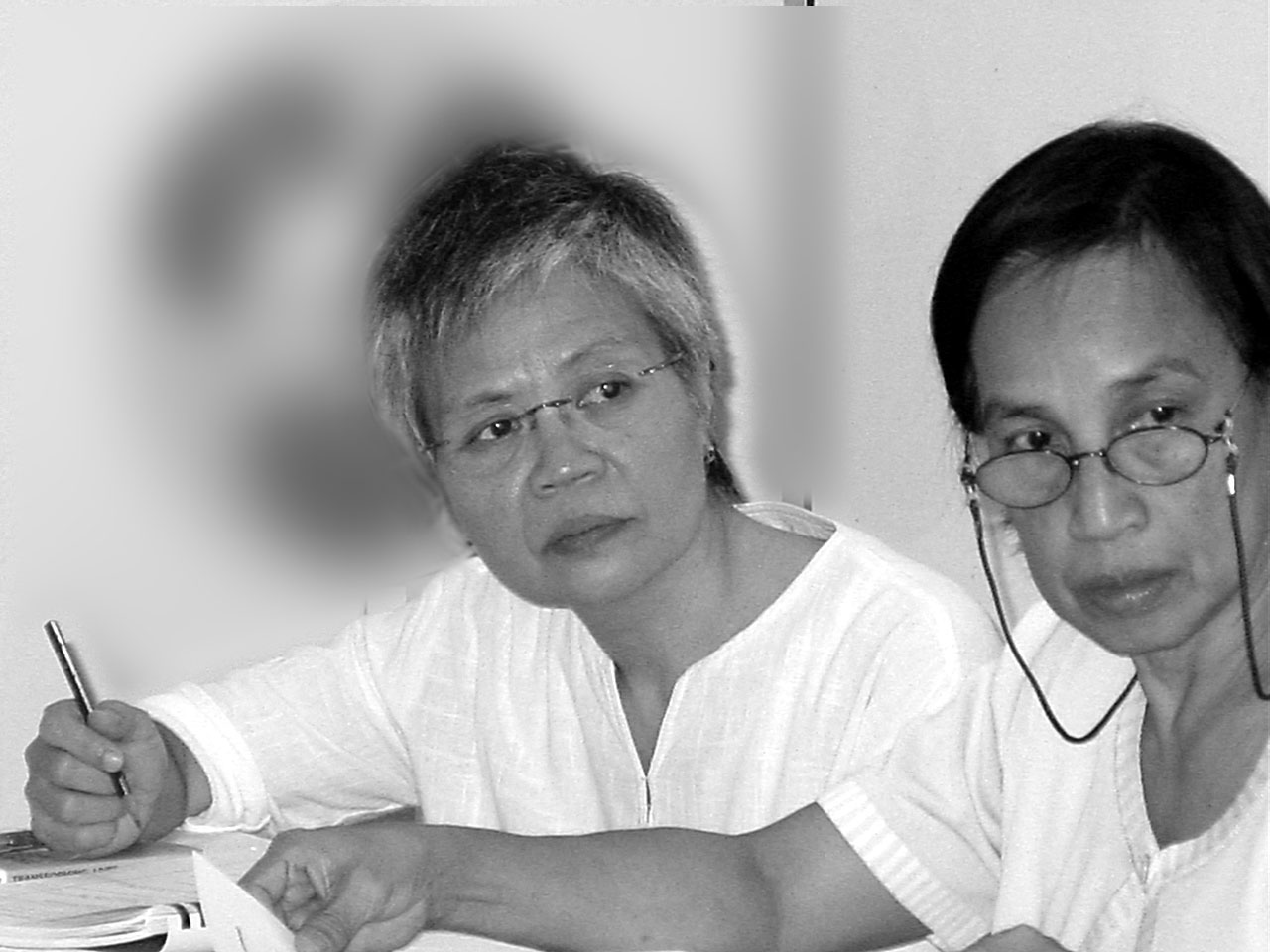
Women in Action [WIA]: In your opinion, how has marriage migration contributed to the further marginalisation of women in Asia?
Leny Tolentino [Leny]: Usually, the women involved in marriage migration come from the less developed countries while the men who are interested to marry these women come from the developed countries. In this kind of situation, you can easily see the power structure coming into play. Men, who hold much of the power since they have the money, marry women who hold less power since they come from poor families. This is one basis for their marginalisation.
Men believe they can buy women through marriage. All expectations come from those holding a more powerful
position. Men expect women to stay in the house to take care of the children and the entire family. If the women fail to perform this role, violence comes into the picture. It’s really difficult to think of solutions to change this situation.
WIA: Being part of KALAKASAN Migrant Women Empowerment Centre, how do you see such a service-oriented organisation playing a role in helping women reverse the situation from victimisation to empowerment?
Leny: Our organisation aims to help migrant women develop self-esteem and feel at home with their own selves, especially those married to Japanese. We have a lot of activities, but I would like to call it actions rather than activities.
In times of crisis, women call the office asking for information. Often they ask, “What should I do because I am in this situation?” After that, we provide direct counseling or consultation. There are women who do not reach this point because they are able to talk and dialogue with their husband. We have very few cases where we encourage the women to assert themselves and to stand for what they believe in. Even in the initial stage, we encourage the women to really stand up and dialogue and be confident in saying what they feel to their partner. It takes a lot of time but there are cases where the husband really listen and change. But when we cannot do anything about the relationship, we offer other alternatives.
Usually, in Japan, the ones tasked to find shelter for victims of domestic violence are the police and the municipal counseling office. We call them to find shelters, the safest place at the time of extreme violence. After that, we provide follow-up care. It’s good that initial support is being extended to the woman at the time of crisis, but follow-up care is more important for us. During this stage, women confront themselves and personally identify all their fears and doubts and what can be done about them. There’s the tendency, many times, to go back to that abusive situation if self-esteem cannot be maintained. Many women have failed during this stage but we still continue to help them.
As a continuous journey with the women, follow-up care takes various forms. One is the home visit. We see what really happens within the household and can really assess the gaps in the relationship. For example, a relationship between a mother and a child. In case the mother is separated from the father of her child, we identify their needs and offer training, such as language or cooking skills. And there’s this Feminist Participatory Action Research (FPAR), where women share their stories among a small group of women. We want to duplicate this in many places. This is like an intimate sharing of life stories. Here, women are able to assess how they view themselves.
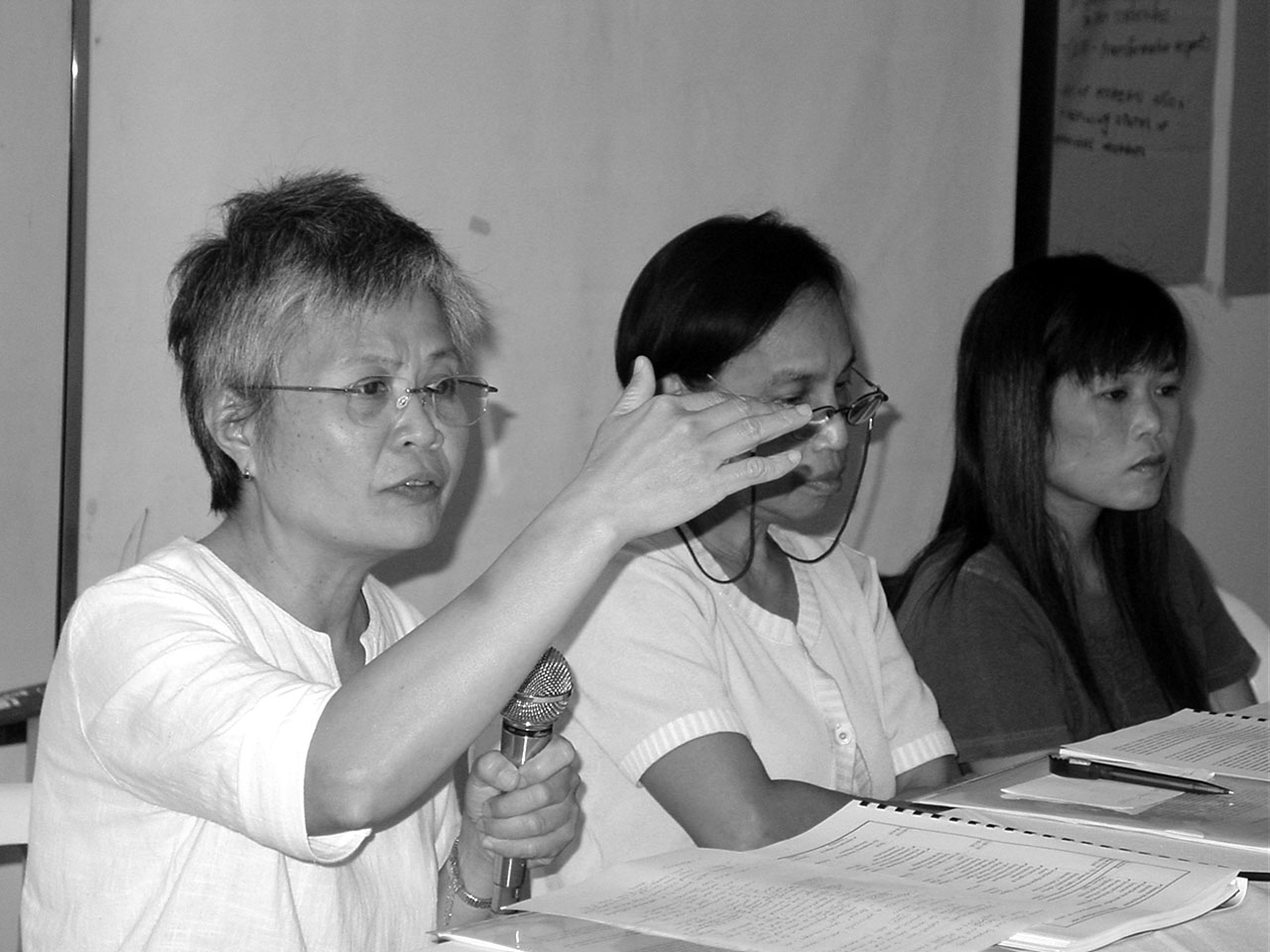 We also have programme for children. It’s a big programme, in sync with the women’s programme, because children are a big problem in marriage migration. In Japan, among three groups of women—Chinese, Korean, Filipino—it’s the Filipino women who bear more children. Usually, the children of Filipino mothers and Japanese fathers are bullied because of their skin color. Classmates make fun of their lack of skills in writing and speaking Japanese, and make fun of the mother’s ways and her spoken Japanese. In extreme cases, some children become ashamed of their mother. So, we have to address the concerns of the women, as well as that of their children. We introduce the children to the larger community and offer English lessons and summer camp. We also have this advocacy work where women themselves speak in public about their experiences. Although not speaking directly to their husband, this activity impacts on men. It somehow helps men change their perception of these women.
We also have programme for children. It’s a big programme, in sync with the women’s programme, because children are a big problem in marriage migration. In Japan, among three groups of women—Chinese, Korean, Filipino—it’s the Filipino women who bear more children. Usually, the children of Filipino mothers and Japanese fathers are bullied because of their skin color. Classmates make fun of their lack of skills in writing and speaking Japanese, and make fun of the mother’s ways and her spoken Japanese. In extreme cases, some children become ashamed of their mother. So, we have to address the concerns of the women, as well as that of their children. We introduce the children to the larger community and offer English lessons and summer camp. We also have this advocacy work where women themselves speak in public about their experiences. Although not speaking directly to their husband, this activity impacts on men. It somehow helps men change their perception of these women.
WIA: How do women mobilise and strategise around issues of marriage migration? How do they turn their personal empowerment towards collective empowerment?
Leny: From their being concerned with individual endeavor, women go beyond their own personal life crisis. We expose these women to counseling, to different seminars and training activities. Gradually, the way they see themselves changes. They realise they are not alone in the situation, even realising that other women, who face the same situation, may have bigger problems. With that consciousness, women participate in various activities, particularly towards policy change on domestic violence. They feel the need to participate in such activities as well as the need to voice out their experiences.
There is this one undocumented instance where one woman lobbied for policy change. She was supported by many other women and did not do it alone. This is one level of contributing collectively, although not as a big group. At the local level, where there are a number of networks, women tell us that if they participate in these gatherings, they have to assert who they are. These women believe that equal treatment, their mutual support of one another, are very important, not only within the family, but also within the larger society.
WIA: How could service-oriented organisations or groups, such as KALAKASAN Centre, further strengthen their advocacy at the local and national or even at the regional and international levels?
Leny: The chance to be here at the 2007 Regional School on Marriage Migration in Asia, to talk about marriage
migration is one instance that KALAKASAN Centre can further its advocacy. We have been doing these things. We are engrossed in our local situation but we feel that we cannot change the situation faced by migrant women without really connecting to other social groups who have the same vision. But since we only have a few people in our organisation, we also have our limitations in addressing the local situation. We feel that we have to do something but it’s probably not the right time. This chance, for example, is a beginning. From today forward, we would have to think of how we can bring back and apply to the community what we have learned from this school.

Human Security and Radical Democracy:A Beginning Position on Marriage Migration
Our Activism and the Research Process
This discussion paper is a product of the Philippine Research Project Team’s (PRPT) explorations into the realities, experiences, and discourses of marriage and migration. The journey took us into an investigation of the multiple reasons and explanations for the condition of marriage migrants, a range of portrayals of victimisation on the one hand, and empowerment—a strategy of autonomy and 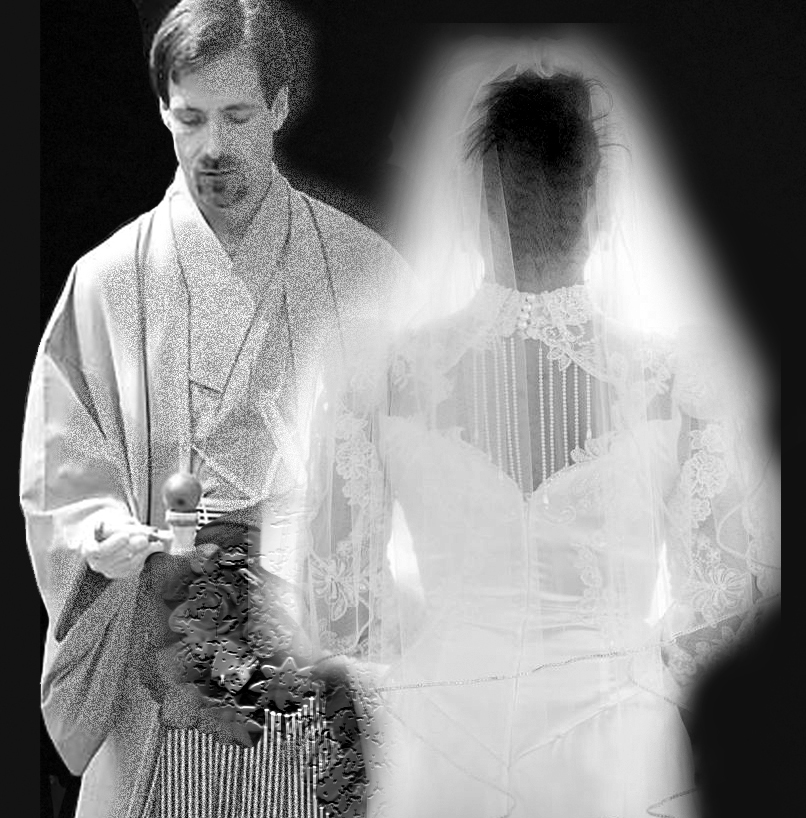 self-determination—on the other. Our numerous discussions were punctuated by forays into migration literature, wading into conceptual areas of identity and nationality, citizenship and diaspora, human security and democracy, marriage and feminism. These themes consistently described relations of power not only in the more overt realms of public life but also, though less frequently, into the more intimate spaces of private relationships and personal lives. It was impossible for us, all feminist researchers, not to identify our activism with the discourses - and view ourselves as feminists engaged in the intellectual phenomenon of theorising lived experiences. Having found relevance in the problematique of marriage and migration, identifying the development issues surrounding marriage migration, framing these into varying perspectives while interrogating the tensions that inevitably arose—brought not only dynamism in our interactions but also a generous amount of laughter, enjoyment and community.
self-determination—on the other. Our numerous discussions were punctuated by forays into migration literature, wading into conceptual areas of identity and nationality, citizenship and diaspora, human security and democracy, marriage and feminism. These themes consistently described relations of power not only in the more overt realms of public life but also, though less frequently, into the more intimate spaces of private relationships and personal lives. It was impossible for us, all feminist researchers, not to identify our activism with the discourses - and view ourselves as feminists engaged in the intellectual phenomenon of theorising lived experiences. Having found relevance in the problematique of marriage and migration, identifying the development issues surrounding marriage migration, framing these into varying perspectives while interrogating the tensions that inevitably arose—brought not only dynamism in our interactions but also a generous amount of laughter, enjoyment and community.
Philippine Project Research Team (PRPT) is a collaboration between Asian Regional Exchange for New Alternatives (ARENA), Isis International-Manila, and Kanlungan Centre Foundation
In the research activities we conducted, we sought to expand our discussion group to include others from both academic and advocacy groups. We held two roundtable discussions (RTD)—first, to unearth the multi-faceted conditions of marriage migrants, their explanations and ambiguities, the understandings of lived experiences. Korean participants were able to join because they were on exposure tour to the Philippines and had made time for us.
The second roundtable discussion involved a continuing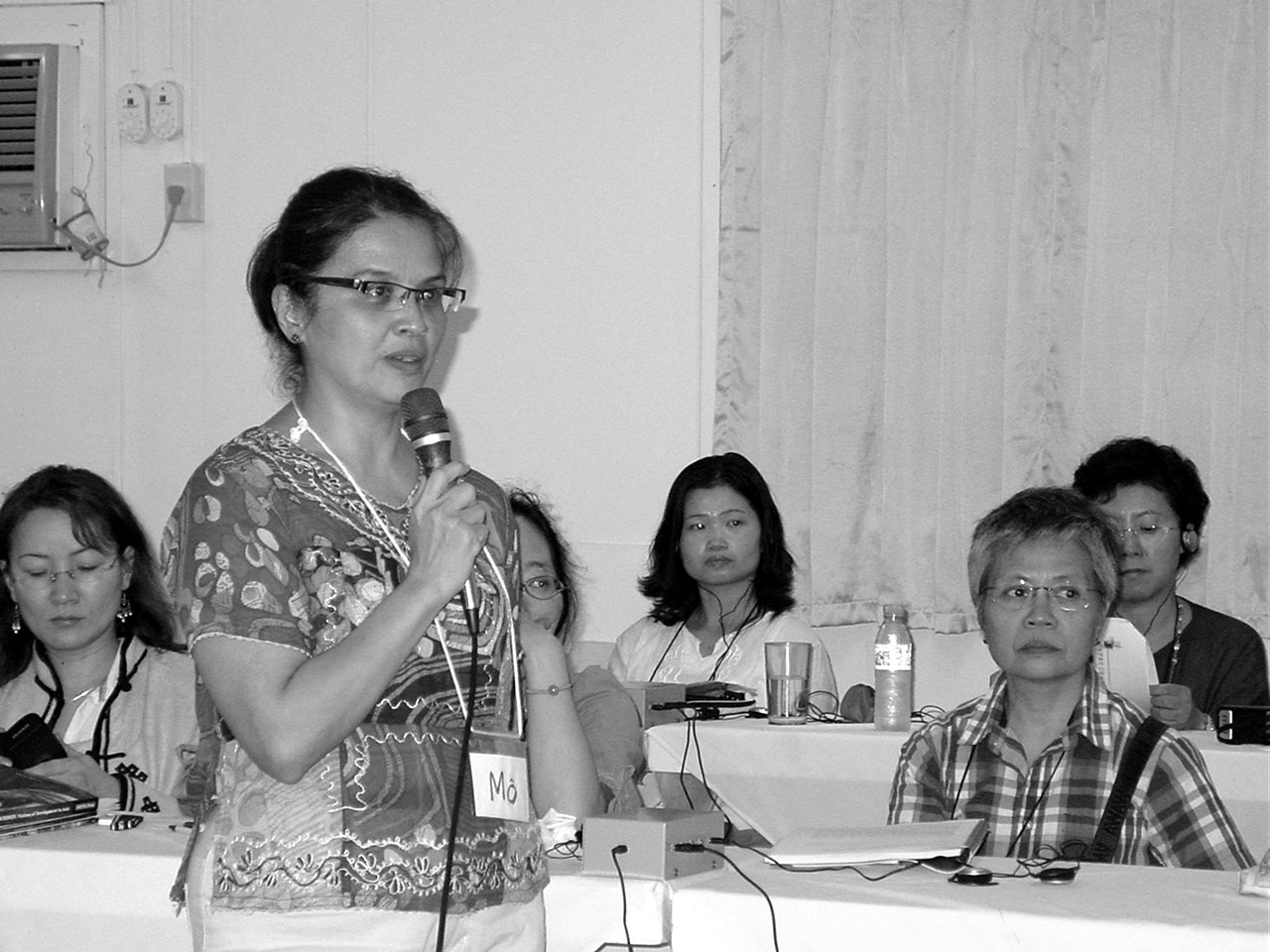 attempt to frame our understandings into a more organised and more substantive weaving of points of analysis that could deepen as well as broaden positions, action, and advocacy. We had hoped that marriage migrants themselves could participate. But of course, they have migrated mostly to Japan, others to South Korea, some to Hongkong and others in Malaysia and Singapore. It was fortunate that even so, one joined us in the first RTD and another we interviewed. The literal space that afforded warmth, vibrancy, and comfort to our coming together was so generously shared by Isis International with bottomless coffee and healthy cooking. But the impetus came from ARENA and our sponsors.
attempt to frame our understandings into a more organised and more substantive weaving of points of analysis that could deepen as well as broaden positions, action, and advocacy. We had hoped that marriage migrants themselves could participate. But of course, they have migrated mostly to Japan, others to South Korea, some to Hongkong and others in Malaysia and Singapore. It was fortunate that even so, one joined us in the first RTD and another we interviewed. The literal space that afforded warmth, vibrancy, and comfort to our coming together was so generously shared by Isis International with bottomless coffee and healthy cooking. But the impetus came from ARENA and our sponsors.
Our final engagement takes the form of a production of a sourcebook. This includes an annotated bibliographic reference and discussion papers on selected themes which the team hopes will be useful to the continuing research on marriage and migration.
This new paradigm of human security aims to “protect people from severe threats, both natural and societal, and empowering individuals and communities to develop the capabilities for making informed choices and acting on their behalf.”
First Stop: Human Security and Marriage Migration
Human Security Definitions
As co-chairs of the UN Commission on Human Security, Sadako Ogata and Amartya Sen define human security as “protecting the vital core of all human lives in ways that enhance human freedoms and human fulfillment.” Human security is a framework to protect vital freedoms as laid down in the Universal Declaration of Human Rights (UDHR) and other HR instruments. This new paradigm of human security aims to “protect people from severe threats, both natural and societal, and empowering individuals and communities to develop the capabilities for making informed choices and acting on their behalf.” It provides a framework based not on a defensive assumption of threats, or “guard against such threats but rather on the creative and integrative effort to prevent these threats from emerging, or to decrease their negative impact when they do by fulfilling all aspects of people’s vital freedoms.”
Given this working definition, an important aspect must be mentioned to provide a comprehensive view of human security as espoused by the United Nations (UN): the notion of freedom from fear and freedom from want. While the former encompasses political and civil freedoms, the latter encompasses economic, social and cultural freedoms. There is recognition now that both freedoms must be promoted simultaneously. While these two freedoms were recognised in the early years of the founding of the UN, freedom from fear was prioritised over freedom from want. Thus, the shift from a national or state-centred security perspective to an all encompassing concept of human security is the prime call of the UN.
The Imperatives for a Feminist Perspective of Human Security
However, inadequacies in some significant areas, as well as the total lack of interrogation of the gendered condition of human society make human security as it is currently expounded grossly insufficient in addressing women’s security including marriage migration.
The framers of the concept of human security intended to secure the freedoms from fear and from want and the exercise of choices in a safe and free environment. These are certainly laudable progressive ideals. To invest in risk assessments, protection, and compensation strategies to ensure human security is, as well, a valuable undertaking.
However, inadequacies in some significant areas, as well as the total lack of interrogation of the gendered condition of human society make human security as it is currently expounded grossly insufficient in addressing women’s security including marriage migration.
The privileging of economic and political rights subordinates the gendered concerns of women. It would seem that the term “human” in human security refers mostly to “man” and his security. Though there is concern for women’s paid work, violence against women, their children, their health and education, much less is said outside of these mainstream framing of roles. The discrimination and violence embedded in the culture, women’s objective and subjective realities, the vast realm of women’s rights that remain unexplored and located in sites of power and contestation (such as subordinated social institutions, their intimate relations, their sexuality, their emotions and spirituality) are all left uninterrogated.
Human security as a notion that is state-focused privileges the public areas of security and ignores the more private realms—the innumerable sites of women’s everyday insecurities. Human security as a response to the organisation of social welfare, rationalises in some way the limitations and constraints to citizenship of marriage migrants. Marriage migrants as national security threats, a depletion not only of the coffers for social services but also of the purity of a nation’s bloodline, makes security of the state a priority, prior to ensuring other securities.
Human security in this sense does not address the view that women and women’s rights are dispensable, treated as mere collateral damage in war times, encouraging the support for militarisms and fundamentalisms. Women are also collateral damages of experiments in development, such as the trade and labour arrangements of states. These tend to commoditise and commercialise any social sphere that can turn giant profits, even marital relationships.
Marriage migrants are in many ways unlike “people on the move” that the migration and human security discourse speaks of. For one, marriage for migration isolates women, moves them from one space into another, in most cases with more severe social and physical immobility and isolation. Marriage for migrants often turns them into unpaid domestic workers, restricted in their movements by husbands, families, and societies. Thus, they are in so many ways not the “people on the move” that the discourse identifies.
Empowering women to be agents of human security is left unaddressed by the current discourse because the securing of women’s political participation and leadership is left uninterrogated.
 Human security privileges rationality by not challenging the binaries of emotion and rationality. Thus, the possibilities of agency and empowerment in the process of marriage migration are overcome by stories of victimisation and powerlessness. When every woman takes the risk to marry and migrate, knowing the dire fate that has befallen other women, rationality dictates that she avoids this situation. But this is not the case. She marries and migrates and soon enough suffers the fate that has been foretold. Her story amazes for its seeming lack of reason and her inadequacy to come to terms with her ill fortune. Often, women are perceived to be all emotions and sorely lacking in rationality. To seem to lack any sense of self-preservation and ability to employ personal faculties opens the migrant to vulnerabilities that bar her from participation in strategies for redress. The situation is so absurd that the only way to describe it is to believe that the woman herself must be benefiting. To add insult to injury, the male who contracts her gets off the hook, his irrationality unquestioned, his intentions unexamined, and his gains normalised.
Human security privileges rationality by not challenging the binaries of emotion and rationality. Thus, the possibilities of agency and empowerment in the process of marriage migration are overcome by stories of victimisation and powerlessness. When every woman takes the risk to marry and migrate, knowing the dire fate that has befallen other women, rationality dictates that she avoids this situation. But this is not the case. She marries and migrates and soon enough suffers the fate that has been foretold. Her story amazes for its seeming lack of reason and her inadequacy to come to terms with her ill fortune. Often, women are perceived to be all emotions and sorely lacking in rationality. To seem to lack any sense of self-preservation and ability to employ personal faculties opens the migrant to vulnerabilities that bar her from participation in strategies for redress. The situation is so absurd that the only way to describe it is to believe that the woman herself must be benefiting. To add insult to injury, the male who contracts her gets off the hook, his irrationality unquestioned, his intentions unexamined, and his gains normalised.
Radical Democracy
The processes whereby human security are secured are ultimately democratic ones where human rights are protected. Thus, it is imperative that women’s security be located or contextualised in these processes. The tradition of democracy that serves as the springboard for its definition is liberal democracy as distinguished from socialist democracy. A major principle of liberal democracy is equality; people-centredness is another. It is also more representational rather than a practice of direct democracy. Participatory democracy strengthens all areas of gover nance and people’s political participation, makes people’s voices heard and substantially considered in public decision-making. This implies the need to strengthen the practice of citizenship to make democracy vibrant.
The gendered condition of political participation, citizenship and democracy constrains women’s participation. Patriarchy as embedded in social, cultural, economic, and political institutions, in everyday relationships, constructs inequalities that substantially make democracy ineffective for women’s participation. These inequalities are even more pronounced for the poor and coloured, young and aged, or the differently abled.
Housewives as liberal democrats seem to be valid only as long as they are identified with their husbands, their status, and social power. Women are primarily constructed as wives, mothers, and daughters—not primarily as citizens. Women’s contribution to community and public life before marriage and before migration are constrained by inequalities in their relationships, making them less informed, more domesticated and isolated. Often, they are seen as dependent, docile, and non-resistant to subordination and marginalisation. Because their experiences, their needs and desires are constantly subject to the interpretation and de-prioritisation of men and families, the women become excluded, submissive and vulnerable. They are rendered non-citizens.
Citizenship, rather than becoming an identity or a signifying force, becomes an activity, referring to continuous
political struggles to be included and named.
Radical democracy takes this condition and challenges the positions prevailing around its understanding. “Radical democratic theory aims to generate an anti-essentialist politics that continually attempts to redefine itself in order to resist the exclusion of individuals and groups in the formation of social order” (Rasmussen and Brown 2002). Drawing from the work of Ernesto Laclau and Chantal Mouffe, both Rasmussen and Brown frame their discourse on citizenship based on a radical democratic experience. Their position leads to a redefinition of the term “political” so as to democratise the notion of “citizenship.” “To expand the field of the political is to expose the hidden source of power within the private sphere”—levels where human beings shape their identity and their relations with the world – sexuality and the construction of the private, forms of entertainment and aesthetic pleasure, etc. Consequently, democracy and its practice become very unfixed, contested and transformative. Citizenship, rather than becoming an identity or a signifying force, becomes an activity, referring to continuous political struggles to be included and named.
Feminist work has constantly sought to unfix the fixed, to challenge the givens of everyday existence. The boundaries of meanings, whether embedded in social structures and macro levels of analysis, in texts and grand narratives, or in privileged strategies are ever pushed from their past rootedness, made to stand the challenge of gender inequalities. Thus, love and marriage, intimacy and desire are taken from their roots to become powerful sites of choice and autonomy, freeing them from past dependence on the male sex, the privileged male social structures and “othering” processes, the makings of the victim identity.
The Democratising of Personal Life
The home and the family as sites of democratic practice, the promotion and development of democratic culture have to be significantly considered for the substantive realisation (not just legal ones), of women’s rights and other human rights. Within these spaces are personal relationships, intimate and sexual.
The importance of rights as means for the achievement of intimacy can easily be seen from the struggle of women to achieve equal status in marriage. The exercise of the right of women to migrate through marriage, a right to seek the means to escape poverty, to seek wealth just like anyone else, without moral stigma, and the more acceptable right to divorce (which is, in most Catholic countries, still a negative sanction) actually has a major equilibrating effect. “Their balancing consequences do more than empower to escape from an oppressive relationship, important though this is. They limit the capability of the husband to impose his dominion and thereby contribute to the translation of coercive power into egalitarian communication” (Giddens).
“No rights without obligation—this elementary precept of political democracy applies also to the realm of the pure relationship. Rights help dissolve arbitrary power only in so far as they carry responsibilities towards the other which draw privileges into an equilibrium with obligations. In relationships as well as elsewhere, obligations have to be treated as revisable in the light of negotiations carried on within them” (Giddens).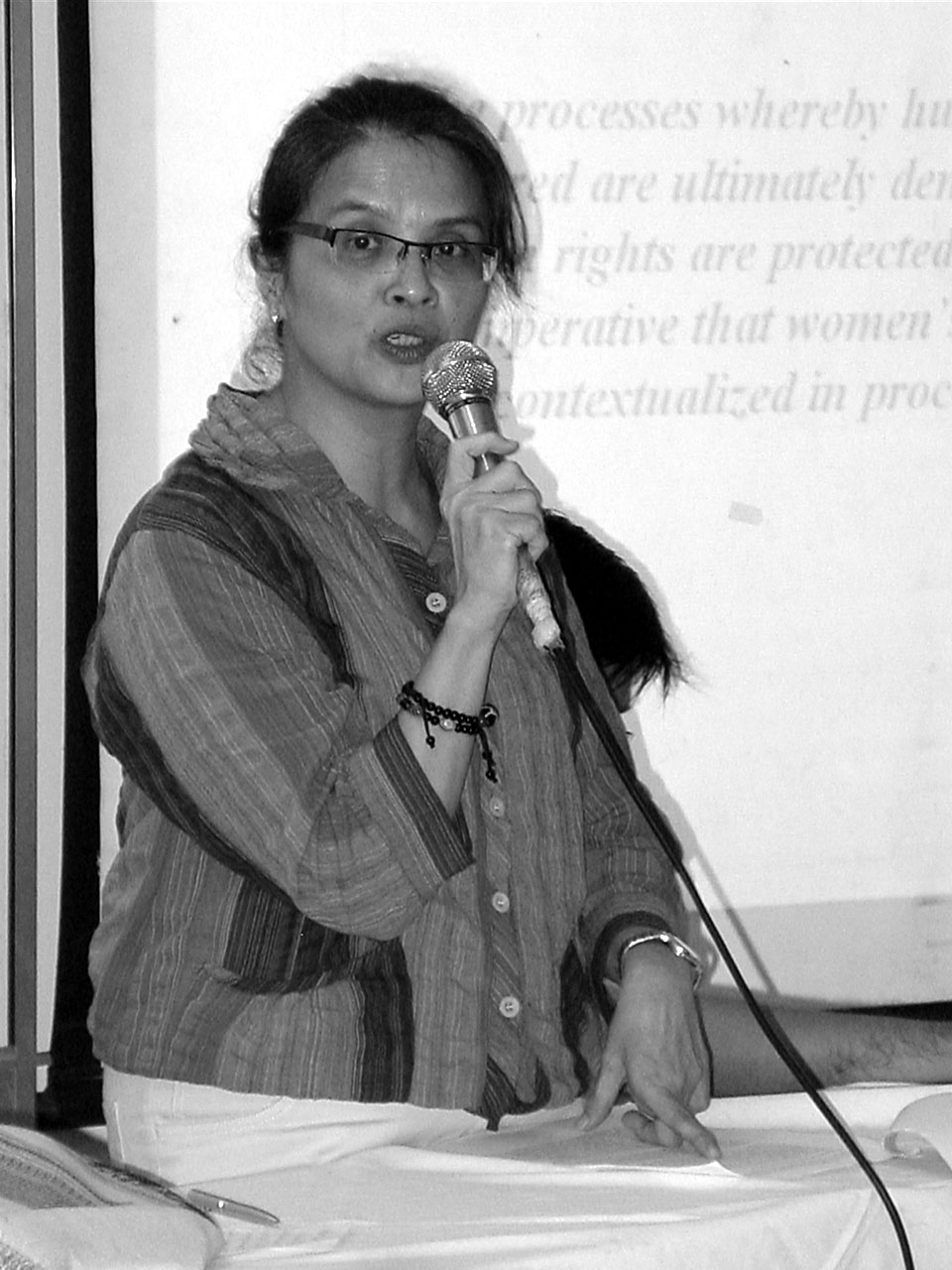
The End, for Now
This paper may seem to be all pure text, as most other papers which informed it. The lived experiences have, it seems, all but disappeared, drowning in ideas and their relationships. In the making of this paper as well as in our discussions, I have often wondered about the power that lies in people who write papers, especially those written and disseminated in English. I remember our own half an hour talk on Diaspora, a word with Jewish roots defining a Filipina, an Asian or Muslim experience of community that I resisted. This, to me, is textual power. When words stick to the description of a condition, signifying identity and meaning, there is something that is not just simply powerful about it but also something I can only identify as spiritual. Perhaps, this is my source of energy, our team’s source of light, a lightness that I hope you engaged with in the process of my presentation.
References
Giddens, A. (2003). “Intimacy as democracy” in Weeks, J., Holland, J. and Waites (eds.), Sexualities and society: A reader. Oxford and Cambridge: Blackwell Publishing Ltd and Policy Press.
Ogato, S. and Cels, J. (2003). “Human security — Protecting and empowering the people.” Global Governance, 9, 273-282.
Rasmussen, C. and Brown, M. (2002). “Radical democratic citizenship: Amidst political theory and geography” in Isin, E. and Turner, B. (eds.), Handbook of Citizenship Studies. London: Thousand
Oaks and New Delhi: Sage Publications.
United Nations Development Programme. (1994). Human Development Report 1994. New York and Oxford: Oxford University Press.
Page 1 of 2





 The
The 
 Isis Resource Center holds one of the largest feminist collections of materials in the Global South. With 40 years of publication experience, Isis holds a vast collection.
Isis Resource Center holds one of the largest feminist collections of materials in the Global South. With 40 years of publication experience, Isis holds a vast collection.